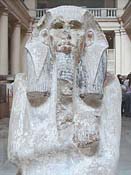King Djoser | Netjerykhet
Historians view the reign of King Djoser as one of the most crucial time periods in the history of Egypt. During his reign, Egypt made great advances in theology, architecture, agriculture, trade, civil service and the arts. Egyptians knew Djoser as “Netjerykhet” throughout his reign. Meaning “godlike of body,” the name reflected the king’s belief that he was the sky god Horus in earthly form.
Family Tree
He was the first Egyptian pharaoh viewed not just as a ruler, but also as a god. Egyptian records first link the name Djoser with the Pharaoh Netjerykhet around 1,000 years after his rule.

© Vincent Brown - Djoser's Ka Chamber
Egyptologists believe the king’s actual birth name was Djoser, which means “holy one”. He ruled during the Third Dynasty of the Old Kingdom of Egypt, which began in approximately 2650 B.C. Confirmed king lists for this time do not exist, leaving the actual dates and reigns of kings uncertain. Researchers recognize Djoser as either the first or second ruler of the dynasty. He ruled for between 19 to 28 years, depending on the source.
Djoser’s family line is mostly unknown. No one knows exactly when he was born. Many Egyptologists believe his mother was Queen Nimaathap, the wife of Khasekhemwy, the last ruler of the Second Dynasty. Some believe that Djoser did not immediately follow his father, but that his brother Nebka ruled before him.
Inscriptions state that his wife was Hetephernebty, the possible daughter of Kha’sekhemwy. Djoser had two daughters and no known sons. Sekhemkhet succeeded him and may have been a possible relative.
Seven Years of Famine
One of the key legends of Djoser involves a great famine that lasted for seven years. After dreaming that the god Khnum was upset over the sorry state of his shrine, Djoser traveled to Elephantine Island at Aswan. Egyptians believed Khnum controlled the flow of the Nile, bringing life to Egypt. Once Djoser built a new temple to honor the god, the famine miraculously ended.

© JT - Funerary Complex of Djoser
Building of Egypt
Records show that Djoser and his predecessors explored the Sinai Peninsula area looking for turquoise and copper. He built many temples and shrines, including a great temple at Heliopolis.
Djoser's accomplishments included the expansion of trade and development of a solid civil service system. During his rule, the religion of Egypt became more sophisticated and organized. The carvings and portraits of King Djoser reveal the rapid advancement and importance of the arts during this time period.
Building a Pyramid
The most famous testament to Djoser is found in a tomb worthy of a god. Djoser chose to break from tradition and built his tomb in the new location of Saqqara. Construction took place under the supervision of his vizier and architect, Imhotep. Known as the step pyramid of Djoser, his tomb became the first monumental stone building in the history of the world.

© Ed Yourdon - Djoser's Step Pyramid
The main purpose of the step pyramid served to protect Djoser for eternity by protecting his mummy and wealth. However, investigations revealed that the tomb had been robbed during antiquity. Egyptologist Jean-Phillippe Lauer cleared the king's burial chamber in 1934. He only found a mummified left foot and other pieces of Djoser’s remains.
Even though his step pyramid failed to protect his immortality, Djoser created a lasting impression of accomplishment and advancement that lasted for the next 2,500 years of Egyptian history.
Quick Facts
- Written texts during his life never refer to him by the name Djoser.
- He successfully kept Upper and Lower Egypt united during his reign.
- Djoser's pyramid contained a life sized statue of him. It currently resides at the Cairo Museum.

